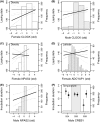Candidate gene-environment interactions and their relationships with timing of breeding in a wild bird population
- PMID: 26380692
- PMCID: PMC4567867
- DOI: 10.1002/ece3.1630
Candidate gene-environment interactions and their relationships with timing of breeding in a wild bird population
Abstract
Monitoring and predicting evolutionary changes underlying current environmental modifications are complex challenges. Recent approaches to achieve these objectives include assessing the genetic variation and effects of candidate genes on traits indicating adaptive potential. In birds, for example, short tandem repeat polymorphism at four candidate genes (CLOCK, NPAS2, ADCYAP1, and CREB1) has been linked to variation in phenological traits such as laying date and timing of migration. However, our understanding of their importance as evolutionary predictors is still limited, mainly because the extent of genotype-environment interactions (GxE) related to these genes has yet to be assessed. Here, we studied a population of Tree swallow (Tachycineta bicolor) over 4 years in southern Québec (Canada) to assess the relationships between those four candidate genes and two phenological traits related to reproduction (laying date and incubation duration) and also determine the importance of GxE in this system. Our results showed that NPAS2 female genotypes were nonrandomly distributed across the study system and formed a longitudinal cline with longer genotypes located to the east. We observed relationships between length polymorphism at all candidate genes and laying date and/or incubation duration, and most of these relationships were affected by environmental variables (breeding density, latitude, or temperature). In particular, the positive relationships detected between laying date and both CLOCK and NPAS2 female genotypes were variable depending on breeding density. Our results suggest that all four candidate genes potentially affect timing of breeding in birds and that GxE are more prevalent and important than previously reported in this context.
Keywords: ADCYAP1; CLOCK; CREB1; GxE; NPAS2; candidate gene; incubation duration; laying date.
Figures


References
-
- Auld JR, Perrins CM. Charmantier A. Who wears the pants in a mute swan pair? Deciphering the effects of male and female age and identity on breeding success. J. Anim. Ecol. 2013;82:826–835. - PubMed
-
- Bates D, Maechler M, Bolker B. Walker S. 2014. , and Linear mixed-effects models using Eigen and S4. R package version 1.1-6. http://CRAN.R-project.org/package=lme4.
-
- Boake CB. Repeatability: its role in evolutionary studies of mating behavior. Evol. Ecol. 1989;3:173–182.
-
- Bourret V, Dionne M, Kent MP, Lien S. Bernatchez L. Landscape genomics in Atlantic salmon (Salmo salar): searching for gene-environment interactions driving local adaptation. Evolution. 2013;67:3469–3487. - PubMed
LinkOut - more resources
Full Text Sources
Other Literature Sources

